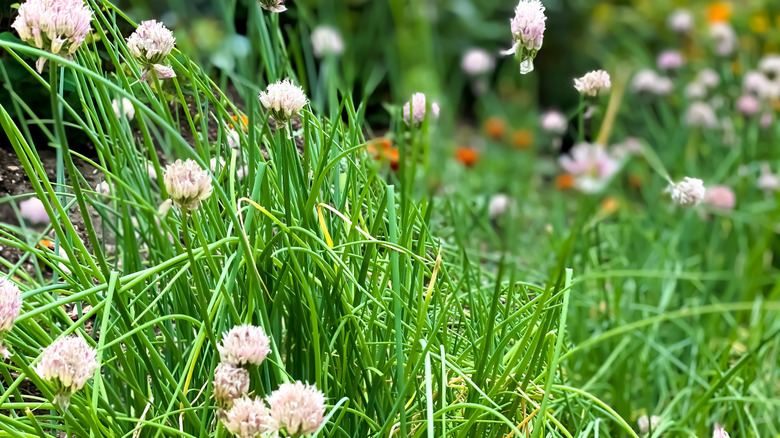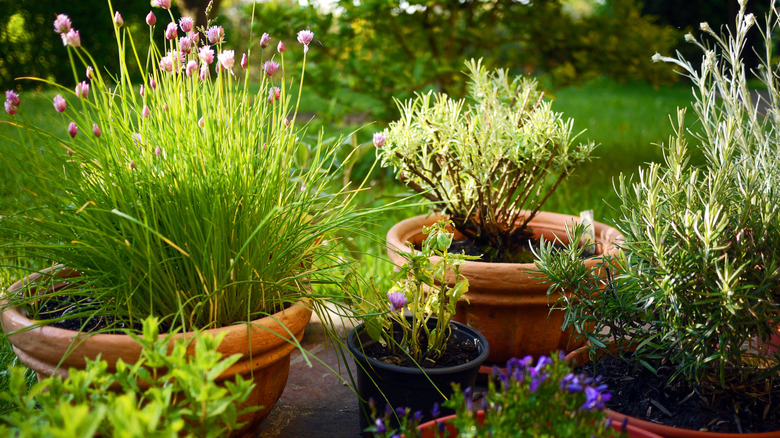Avoid These Mistakes Gardeners Commonly Make When Growing Chives
Herbs add a flavorful punch to your dishes and make a pretty addition to your garden. That includes chives (Allium schoenoprasum), which grow in USDA zones 3 to 9. Whether you plant them in the ground or in a pot, chives grow in clumps with tall, hollow leaves and light purple flowers that add color to the garden. Even though they're easy to grow, chives do need particular conditions and care to thrive. Common mistakes that gardeners make with chives include planting them in shady areas with poor-quality soil near the wrong companion plants. After planting, common mistakes include incorrect watering, lack of nutrients, and inadequate harvesting.
Learning which chive-growing mistakes to avoid helps you achieve an abundant crop of the fragrant, flavorful herb. The green stems add a mild onion flavor to your meals, but don't confuse chives for green onions or scallions — they're vegetables while chives are herbs. Chives are also beneficial for companion planting because they repel several harmful garden pests. It's worth it to master growing this favorite herb, but watch out for these mistakes.
Planting chives in the wrong location
Thinking of tucking your chives into a shady corner of your garden? That's a mistake that will likely affect your harvest. Chives prefer 6 to 8 hours of direct sunlight, so find them a spot in full sun. The ideal spot for growing chives has nutrient-rich, well-draining soil. You can work in compost to add nutrients before planting the herbs. Their preferred soil pH range is between 6 and 7.
When choosing the location, consider what you're planting nearby. Chives are good companions for many plants — it's an easy-to-grow herb that will help your cucumber plants, carrots, tomatoes, and many other vegetables. However, there are some plants you should avoid when you're planting chives, including peas, beans, asparagus, and spinach. Asparagus and chives can stunt each other's growth because chemicals released from chives can affect asparagus, and the plants often fight for the same nutrients. Spinach and peas can both overtake the chive plants, and spinach typically needs more moisture than chives. Beans become a problem because they can increase the nitrogen levels in the soil, and too much nitrogen can affect the growth and flavor of chives.
You can start your chives early since they're a cool-season herb — if you're growing them from seeds, start them indoors about 6 to 8 weeks before the last frost date in your area. Transplant young seedlings outdoors once there's no longer a chance of frost, leaving about 6 to 12 inches between the plants gives each one enough space to grow well.
Getting the watering and care wrong
Too much water could kill chives by causing root rot. The leaves will droop and wilt if the plant is overwatered. To avoid overwatering them, check the soil often to make sure it stays moist without being soggy or saturated. Potted chives need adequate drainage holes to prevent water from building up in the soil. Underwatering also affects the growth of chives. When you use the chives from your garden, you might notice that they don't have much flavor, so you may need to increase your watering during the warmer parts of the growing season. How quickly the soil drains also impacts the frequency of watering that's required. Adding a layer of mulch helps retain the moisture longer and protects the bulbs of your chive plants, which are close to the surface.
Another common mistake when growing chives is not providing enough nutrients for the herbs. It helps to start with nutrient-rich soil, but adding fertilizer may also be necessary. You'll know that your chives need more nutrients if they start to turn yellow. Be cautious about giving chives too much nitrogen, which can hurt the roots and burn the plant.
Chive plants often decline if you don't harvest and divide them properly. Cut the leaves at the base of the plant about 1 to 2 inches above the soil. It's also important to deadhead the flowers when they're finished blooming. If you leave them, the plant will start to form seeds and growth may slow down. Dividing your chive plants every 3 to 4 years keeps them from getting overgrown and helps keep productivity high.


